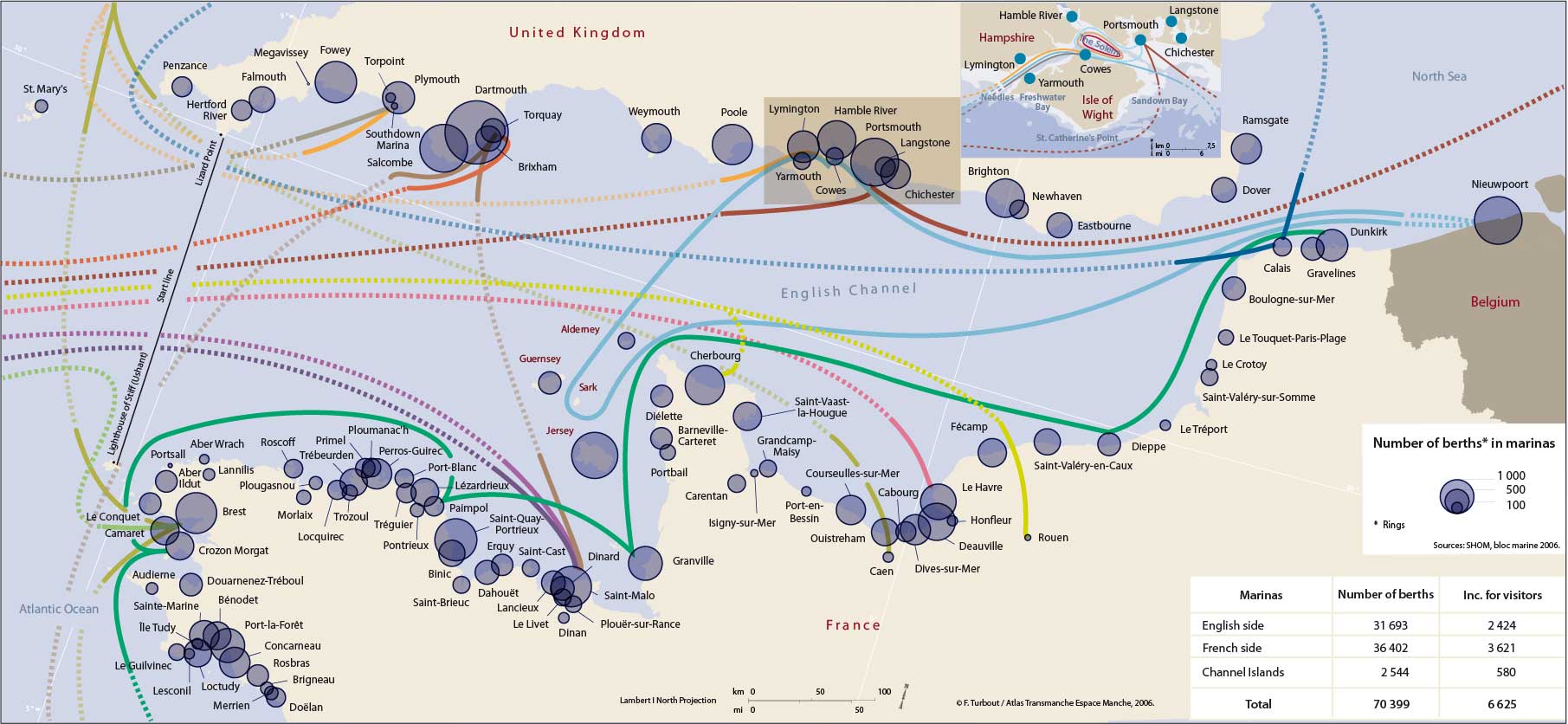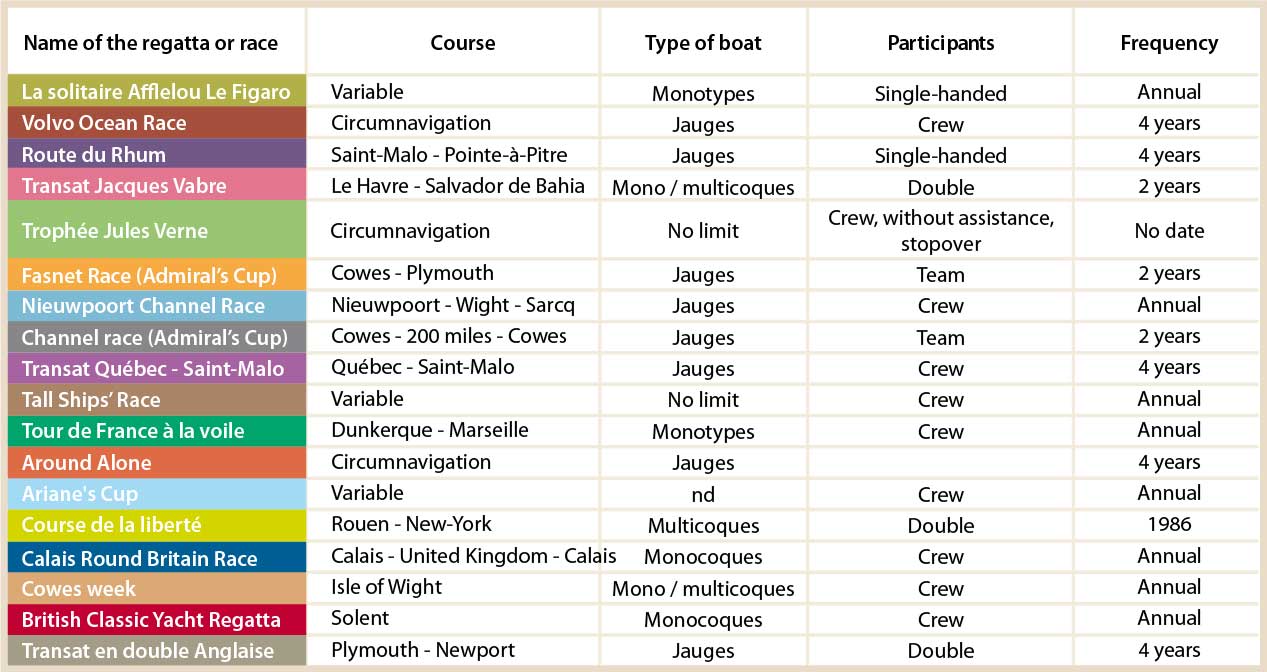

 Tourism - Recreational boating
Tourism - Recreational boating- Le poids économique du tourisme (2018) FR
- Recreational boating (2006)
- Recreational yachting (2009-2012)
- Tourism (2005)
- Tourisme (2014) FR
The heights of Cap Fréhel are crowded with people, thousands of them, packed close together; they have been standing in the wind for hours, gazing seaward. On the ocean, hundreds of boats of all sizes are heading the same direction; in their midst, a flotilla of multi-hulled craft with multi-coloured sails. They are still in a group, for the heightened pleasure of the spectators, before going their separate ways as they sail out into the wide Atlantic. This is the start of the Route du Rhum, a single-handed transatlantic race from Saint-Malo to Pointe-à-Pitre, which has a following in the hundreds of thousands while it runs its course, and motivates the most passionate amongst them to come to the jetties and coastal cliffs to admire these marvels of marine technology.
Ocean racing is the publicity-grabbing, industrial and financial cutting edge of leisure cruising. The latter covers a wide range: traditional sailing, from the smallest boats to the most sophisticated cruising yachts. Sailing activities became very popular in the last third of the 20th century. This same interest in the sea has affected another group of people attracted by motor cruising, which has undergone major expansion in the past two decades. There is an increased demand for the very high-quality range of products now available for wealthy customers; magnificent sailing or motor yachts with the most refined of fittings and costing several million euros each are on sale.
Resulting from this interest, a whole sector of economic activity has been constructed around nautical activities and leisure cruising. This includes the design and manufacture of boats, from small fibreglass craft a few metres long to the huge 40-metre yachts that require the use of high-tech equipment and materials. There is also the design and manufacture of masts, sails and fittings, the construction and management of marinas...
All these activities generate an impressive presence on both sides of the English Channel, which is amongst the largest leisure sailing catchment areas in the world. It has anteriority: a long and grand maritime history that has been the basis for the birth and development of leisure sailing. The roots of this history are the dozens of ports, large and small, where generations of men have frequented the sea and faced its dangers to earn their livelihoods. The geographical configuration of a narrow sea with hundreds of tidal estuaries, shelters, and river-mouths, have offered safe moorings. The proximity of densely populous zones has added an increasingly large pool of amateur yachtsmen.
The very first English and French yacht clubs were created on these shores: the Royal Yacht Squadron in Cowes, in 1815, and its counterpart, the Société des Régates in Le Havre, in 1838. On 10 August 1826, seven yachts competed in a race at Cowes. The tradition has never fallen into abeyance and Cowes Week is now an international event during which 1 000 yachts compete in a wide range of categories. It was also from Cowes that the first Fastnet Race was launched in 1925, a 605 mile race which finishes in Plymouth, after circumnavigating Ireland's Fastnet Rock lighthouse.
Today, more than ten major races pass through the waters of the Channel: the single-handed Figaro, the Fastnet Race, the Admiral's Cup, the Tall Ships, the Route du Rhum, the Jacques Vabre transatlantic race, the Quebec - Saint-Malo transatlantic race, the Tour de France à la Voile, and the big transoceanic races – the Jules Verne Trophy, and the Volvo Ocean Race, formerly the Whitbread.
Besides these events, thousands of sailors explore the Solent or the Normandy-Brittany gulf, sailing between ports along the English or French coast and cross the Channel, (predominantly British sailors making the return voyage to France) and between the mainland and the Channel Islands.
All this cruising activity has given rise to a large number of marinas. There are 161 overall, 96 in France, 57 in England, and 8 in the Channel Islands. They vary widely in size, from the 95 berths in Le Tréport or Lesconil, to 1 100 in Le Havre, 1 200 in Saint-Malo, and 1 300 in Cherbourg or, in England, from 80 berths in Brixham or Torpoint to the 900 in Portsmouth's Port Solent Portsmouth, 1 300 in Brighton, 2 000 in Salcombe, 3 500 in Darmouth and 9 000 in Chichester. In addition to this large number of ports, there are hundreds of more informal anchorages and moorings.
Though large, this provision is an inadequate response to high demand. Most ports have very long waiting lists, sometimes up to several years. There are numerous projects for the creation of new marinas, but the need to conserve the environment and promote coexistence with the other activities on the coast and on this narrow band of sea, is difficult to manage.
On the English side, marine industries are particularly concentrated on the South coast. Numerous boatyards, building a variety of craft from traditional wooden boats to smaller dinghies and yachts are to be found among the thirty marinas or on the tidal estuaries. The world's biggest constructor of leisure motor cruisers is located in Poole Harbour and the Camper and Nicholson Yachting Yard, the prestige yacht builder that opened in 1782, is still to be found in Gosport. In France, besides the regular maintenance and construction activity base, other points are worthy of note: the north coast of Brittany, where each port and ria has its workshops and shipyards; Port-la-Forêt, the ocean racing technological site that is also a base for skippers of renown; Cherbourg and Caen in Normandy where high-tech masts and sails are produced, where boatyards produce luxury yachts and where a base for the preparation of yachts for the major races has welcomed Ellen MacArthur, and Christophe Auguin, amongst others. The expansion of leisure boating has offered the businesses of the Channel seaboard the opportunity to turn their history and experience, to say nothing of their more recent technological innovations, to good account.
Leisure cruising and the nautical industries in general are already well established in the Channel and will continue to assert themselves in all their forms: big races and technology, of course… but the Sunday outing will also continue to thrive.
top














